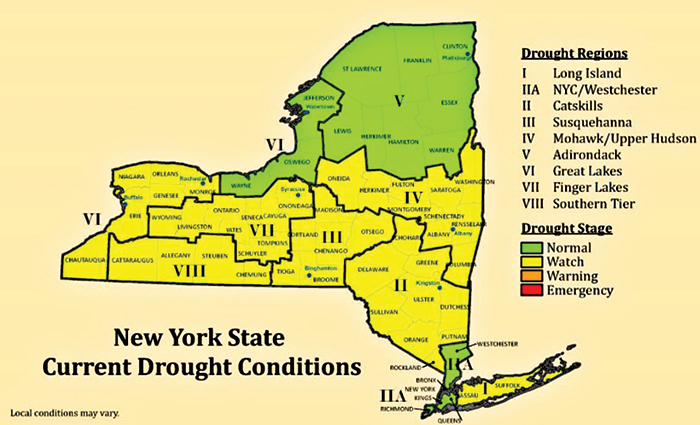Courtesy of DEC
By Forum Staff
Governor Kathy Hochul on Tuesday directed the State Department of Environmental Conservation to issue an updated drought watch after consulting with the State Drought Management Task Force and federal partner agencies.
The watch now includes most New York counties except those located in the Adirondack, Eastern Great Lakes, and New York Metropolitan regions. New York State is encouraging residents in affected counties, particularly those dependent on private groundwater wells, to conserve water whenever possible during the coming weeks.
A watch is the first of four levels of State drought advisories, which are watch, warning, emergency, and disaster. No mandatory restrictions are in place under a state drought watch, Hochul noted.
An increasing number of water supply challenges are being reported due to dry conditions. Below-normal precipitation during the last three months, low stream flows and low groundwater levels prompt the need for the expansion of the watch status to ensure adequate public water supplies. Local public water suppliers are urged to assess the current situation, promote voluntary conservation, and take appropriate actions to manage risk.
New York State drought region IIA, which includes New York City and Westchester, remains in normal status due to the satisfactory storage levels and refill probability of the New York City reservoirs. According to the City Department of Environmental Protection (DEP), the City’s reservoirs are approximately nine percent below normal for this time of year, with 422 billion gallons currently in storage, compared to 469 billion gallons normally. DEC continues to work closely with DEP to monitor reservoir conditions and encourage responsible water use, especially outdoors, regardless of the hydrological conditions or season.
The drought watch is triggered by the State Drought Index, which reflects precipitation levels, reservoir/lake levels, and stream flow and groundwater levels in the nine drought regions of the state. Each of these indicators is assigned a weighted value based on its significance to various uses in a region. The State Drought Index is attuned to the specific attributes of New York and may differ moderately from some national technical drought assessments.
DEC and U.S. Geological Survey are partners in evaluating hydrologic conditions across New York State. In addition, DEC supports efforts by local governments and stakeholders to undertake water conservation measures based on specific local circumstances. Observed precipitation has been less than normal with shortfalls of two to six inches common over the last 90 days. The dry weather began in the spring and is beginning to significantly affect other metrics. Stream flows and groundwater levels are well below normal throughout much of the affected regions. Groundwater levels have been declining over the past few months and they are not expected to improve in the immediate future due to the existing precipitation deficit.
The National Weather Service outlook for the remainder of the summer predicts above-normal temperatures and below-normal precipitation.
To protect water resources, homeowners are encouraged to voluntarily reduce outdoor water use and follow these tips:
- Water lawns only when necessary, choose watering methods that avoid waste, and water in the early morning to reduce evaporation and maximize soil hydration;
- Reuse water collected in rain barrels, dehumidifiers, or air conditioners to water plants;
- Raise lawn mower cutting heights. Longer grass is healthier with stronger roots and needs less water;
- Use a broom, not a hose, to clean driveways and sidewalks; and
- Fix leaking pipes, hoses, and faucets.

